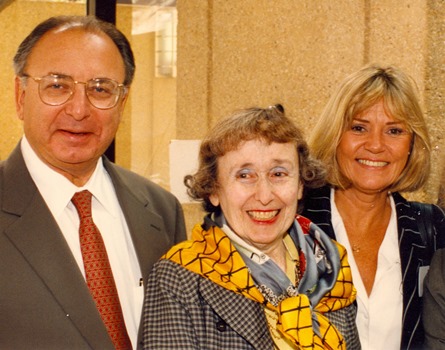 Members of the BENDANN FAMILY are historically humanitarians. Dating back to the Civil War, Daniel and David Bendann saw the need to photograph soldiers both for military records and their families. After the war, they opened an art gallery in New York; eventually, they moved to Baltimore and split the business. Daniel remained focused on photography, and David opened the Bendann Art Galleries. His son Maurice took over the art gallery with his brother Laurence. Maurice married Violet S. Mansbach in 1915.
Members of the BENDANN FAMILY are historically humanitarians. Dating back to the Civil War, Daniel and David Bendann saw the need to photograph soldiers both for military records and their families. After the war, they opened an art gallery in New York; eventually, they moved to Baltimore and split the business. Daniel remained focused on photography, and David opened the Bendann Art Galleries. His son Maurice took over the art gallery with his brother Laurence. Maurice married Violet S. Mansbach in 1915.
After retiring from the art gallery in 1939, Maurice Bendann advocated a plan in 1940 to save Baltimore from “drying out of the center.” He proposed that the State Legislature allow privately financed organizations to acquire blighted city blocks. The organizations could then renovate the blocks and bring new life to the center of the city. As a result, Mount Vernon Place and its surrounding blocks have remained “the most beautiful square in any city in the country.”
Maurice and Violet Bendann were also generous friends of the Johns Hopkins University, especially dedicated to supporting the Wilmer Eye Institute. Maurice Bendann died in 1969, directing much of his estate to the Wilmer Institute. Constance Bendann, Violet and Maurice’s daughter, was a Baltimore art connoisseur and owned art galleries in Baltimore and New York.
Constance Bendann was an active member of the auxiliary of the Women’s Board at Johns Hopkins Hospital. She was also a member of the Wilmer Advisory Council.
The Wilmer Eye Institute is grateful to the Bendann Family for their generosity and for supporting our mission of changing the way the world sees.
Held by Esen Karamursel Akpek
 ESEN KARAMURSEL AKPEK, MD, is the Bendann Family Professor of Ophthalmology at the Johns Hopkins University School of Medicine and has been on the surgical faculty of the Wilmer Eye Institute since 1999. She is an internationally renowned leader in the field of corneal transplantation and serves as the medical director of the Eye Bank of Maryland and member of the National Medical and Scientific Advisory Board of Tissue Banks International.
ESEN KARAMURSEL AKPEK, MD, is the Bendann Family Professor of Ophthalmology at the Johns Hopkins University School of Medicine and has been on the surgical faculty of the Wilmer Eye Institute since 1999. She is an internationally renowned leader in the field of corneal transplantation and serves as the medical director of the Eye Bank of Maryland and member of the National Medical and Scientific Advisory Board of Tissue Banks International.
Currently, Dr. Akpek is the director of the fellowship program in cornea and external disease at Wilmer and has trained numerous ophthalmologists who have become leaders in the field. She has been invited to lecture extensively within the United States as well as abroad. Dr. Akpek has published over 100 peer-reviewed articles and many book chapters and has directed multiple online and in-person educational activities. Dr. Akpek holds a patent in the field of keratoprosthesis devices and has been awarded the Cora Verhagen Immunology Prize, the American Academy of Ophthalmology Achievement Award, and other honors. She serves on the editorial board of 11 scientific journals and is a member of the Clinical Trials Consortium, Sjogren’s Syndrome Foundation, and the Medical & Scientific Advisory Board of the Tear Film and Ocular Surface Society.
Dr. Akpek specializes in the surgical treatment of corneal and ocular surface diseases. She performs all types of donor and artificial corneal transplantation surgeries. Dr. Akpek also specializes in difficult and challenging cataract surgeries and complicated cases of anterior segment reconstruction procedures. As director of the Ocular Surface Disease and Dry Eye Clinic, she cares for patients with inflammatory eye disorders such as Sjogren’s Syndrome, allergic and immunologic diseases of the cornea and the conjunctiva, scleritis, and uveitis.
Dr. Akpek received her medical degree from Hacettepe University in Ankara, Turkey. Following her internship and residency training in Ankara, she completed subspecialty training in ocular immunology and uveitis at the Massachusetts Eye and Ear Infirmary, Harvard University Medical School. She then completed a surgical fellowship program in cornea, cataract, and external diseases at the Wilmer Eye Institute.
 Members of the BENDANN FAMILY are historically humanitarians. Dating back to the Civil War, Daniel and David Bendann saw the need to photograph soldiers both for military records and their families. After the war, they opened an art gallery in New York; eventually, they moved to Baltimore and split the business. Daniel remained focused on photography, and David opened the Bendann Art Galleries. His son Maurice took over the art gallery with his brother Laurence. Maurice married Violet S. Mansbach in 1915.
Members of the BENDANN FAMILY are historically humanitarians. Dating back to the Civil War, Daniel and David Bendann saw the need to photograph soldiers both for military records and their families. After the war, they opened an art gallery in New York; eventually, they moved to Baltimore and split the business. Daniel remained focused on photography, and David opened the Bendann Art Galleries. His son Maurice took over the art gallery with his brother Laurence. Maurice married Violet S. Mansbach in 1915.